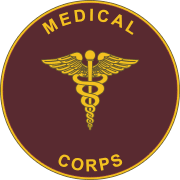Template:Caduceus confusion summary

It is relatively common, especially in the United States, to find the caduceus, with its two snakes and wings, (mis)used as a symbol of medicine instead of the Rod of Asclepius, with only a single snake. This usage was popularized by the adoption of the caduceus as its insignia by the U.S. Army Medical Corps in 1902 at the insistence of a single officer (though there are conflicting claims as to whether this was Capt. Frederick P. Reynolds or Col. John R. van Hoff).[1][2]
The Rod of Asclepius is the dominant symbol for professional healthcare associations in the United States. One survey found that 62% of professional healthcare associations used the rod of Asclepius as their symbol.[3] The same survey found that 76% of commercial healthcare organizations use the caduceus. The author of the study suggests that professional associations are more likely to have a historical understanding of the two symbols, whereas commercial organizations are more likely to be concerned with the visual impact a symbol will have on its sales.[3]
The long-standing historical association of the caduceus with commerce has engendered significant criticism of its use in medicine. Medical professionals argue that the Rod of Asclepius better represents the field of medicine.[4] Writing in the journal Scientific Monthly, Stuart L. Tyson said of the Staff of Hermes (the caduceus):
As god of the high-road and the market-place Hermes was perhaps above all else the patron of commerce and the fat purse: as a corollary, he was the special protector of the traveling salesman. As spokesman for the gods, he not only brought peace on earth (occasionally even the peace of death), but his silver-tongued eloquence could always make the worse appear the better cause.[5] From this latter point of view, would not his symbol be suitable for certain Congressmen, all medical quacks, book agents and purveyors of vacuum cleaners, rather than for the straight-thinking, straight-speaking therapeutist? As conductor of the dead to their subterranean abode, his emblem would seem more appropriate on a hearse than on a physician's car.
— Stuart L. Tyson, "The Caduceus", in the Scientific Monthly, 1932[6]
References
- ^ F.H. Garrison, "The Use of the Caduceus in the Insignia of the Army Medical Officer", in Bull. Med. Lib. Assoc. IX (1919-20), 13-16
- ^ Engle, Bernice (Dec 1929). "The Use of Mercury's Caduceus as a Medical Emblem"". The Classical Journal. 25 (1): 205.
- ^ a b Friedlander, Walter J (1992). The Golden Wand of Medicine: A History of the Caduceus symbol in medicine. Greenwood Press. ISBN 0-313-28023-1.
- ^ Bohigian, George (2019). "The Caduceus vs. Staff of Aesculapius - One Snake or Two?". Missouri Medicine. 116 (6): 476–477.
"The Staff of Aesculapius has represented medicine since 800 BCE and most authorities support its use as the symbol of medicine
- ^ An allusion to John Milton's description of Belial in Paradise Lost II.113-114.
- ^ Tyson, Stuart L (1932). "The Caduceus". Scientific Monthly. 34 (6): 495.
| This template's documentation is missing, inadequate, or does not accurately describe its functionality or the parameters in its code. Please help to expand and improve it. |
